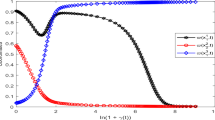Abstract
This paper investigates the general properties of symmetric n-player supermodular games with complete-lattice action spaces. In particular, we examine the extent to which all pure strategy Nash equilibria tend to be symmetric for the general case of multi-dimensional strategy spaces. As asymmetric equilibria are possible even for strictly supermodular games, we investigate whether some symmetric equilibrium would always Pareto dominate all asymmetric equilibria. While this need not hold in general, we identify different sufficient conditions, each of which guarantees that such dominance holds: 2-player games with scalar action sets, uni-signed externalities, identical interests, and superjoin payoffs. Various illustrative examples are provided. Finally, some economic applications are discussed.
Similar content being viewed by others
References
Amir R (1996). Cournot oligopoly and the theory of supermodular games. Games Econ Behav 15: 132–148
Amir R (2000). R&D returns, market structure and research joint ventures. J Inst Theor Econ 156: 583–598
Amir R and Lambson V (2000). On the effects of entry in Cournot markets. Rev Econ Stud 67: 235–254
Amir R and Wooders J (2000). One-way spillovers, endogenous innovator/imitator roles and research joint ventures. Games Econ Behav 31: 1–25
Athey S (2001). Single-crossing properties and existence of pure strategy equilibria in games of incomplete information. Econometrica 69: 861–890
Bulow J, Geanokoplos J and Klemperer P (1985). Multimarket oligopoly: strategic substitutes and complements. J Polit Econ 93: 488–511
Cooper R (1999). Coordination games: complementarities and macroeconomics. Cambridge University Press, Cambridge
Echenique F (2003). The equilibrium set of two player games with complementarities is a sublattice. Econ Theory 22: 903–905
Echenique F (2004). A characterization of strategic complementarities. Games Econ Behav 46: 325–347
Echenique F (2005). A short and constructive proof of Tarski’s fixed-point theorem. Int J Game Theory 33: 215–218
Fudenberg D and Tirole J (1984). The fat-cat effect, the puppy-dog ploy and the lean and hungry look. Am Econ Rev 74: 361–366
Hermalin B (1994). Heterogeneity in organizational form: why otherwise identical firms choose different incentives for their managers. Rand J Econ 25: 518–537
Matsuyama K (2002). Explaining diversity: symmetry-breaking in complementarity games. Am Econ Rev 92: 241–246
Milgrom P and Roberts J (1990). Rationalizability, learning and equilibrium in games with strategic complementarities. Econometrica 58(6): 1255–1277
Milgrom P and Shannon C (1994). Monotone comparative statics. Econometrica 62: 157–180
Mills D and Smith W (1996). It pays to be different: endogenous heterogeneity of firms in oligopoly. Int J Indus Organ 14: 317–329
Monderer D and Shapley L (1996). Fictitious play property for games with identical interests. J Econ Theory 68: 258–265
Shannon C (1994). Weak and strong monotone comparative statics. Econ Theory 5: 209–227
Tarski A (1955). A lattice-theoretic fixed point theorem and its applications. Pacific J Math 5: 285–309
Topkis D (1978). Minimizing a submodular function on a lattice. Oper Res 26: 305–321
Topkis D (1998). Supermodularity and complementarity. Princeton University Press, New Jersey
Vives X (1990). Nash equilibrium with strategic complementarities. J Math Econ 19: 305–321
Vives X (1999). Oligopoly pricing: old ideas and new tools. The MIT Press, Cambridge
Weibull JW (1995). Evolutionary game theory. MIT Press, London
Author information
Authors and Affiliations
Corresponding author
Additional information
The first version of this paper was completed while M. Jakubczyk and M. Knauff were visiting junior scholars at CORE, Louvain-la-Neuve, Belgium, financed through the Marie-Curie Early Stage Training program of the European Union (under contract no HPMT-CT-2001-00327), which is hereby gratefully acknowledged. The presentation of the revised version of this paper has benefitted from detailed and careful suggestions by two anonymous referees and William Thomson (as editor) of this Journal.
Rights and permissions
About this article
Cite this article
Amir, R., Jakubczyk, M. & Knauff, M. Symmetric versus asymmetric equilibria in symmetric supermodular games. Int J Game Theory 37, 307–320 (2008). https://doi.org/10.1007/s00182-008-0118-5
Accepted:
Published:
Issue Date:
DOI: https://doi.org/10.1007/s00182-008-0118-5
Keywords
- Strategic complementarity
- Endogenous heterogeneity
- Symmetry breaking
- Doubly symmetric games
- Superjoin payoffs




